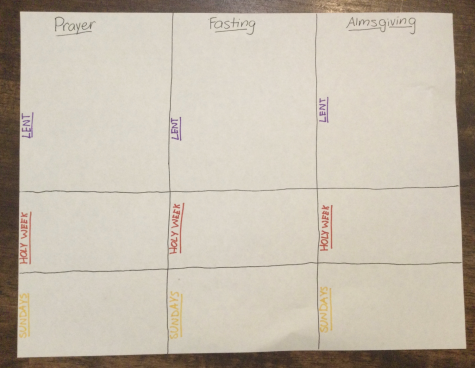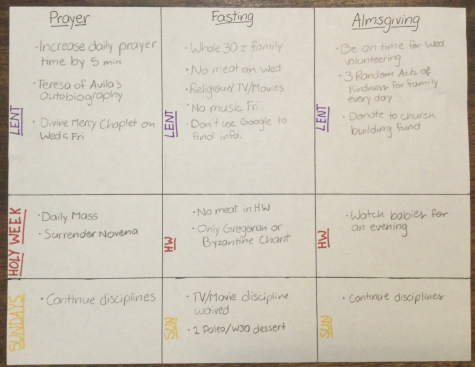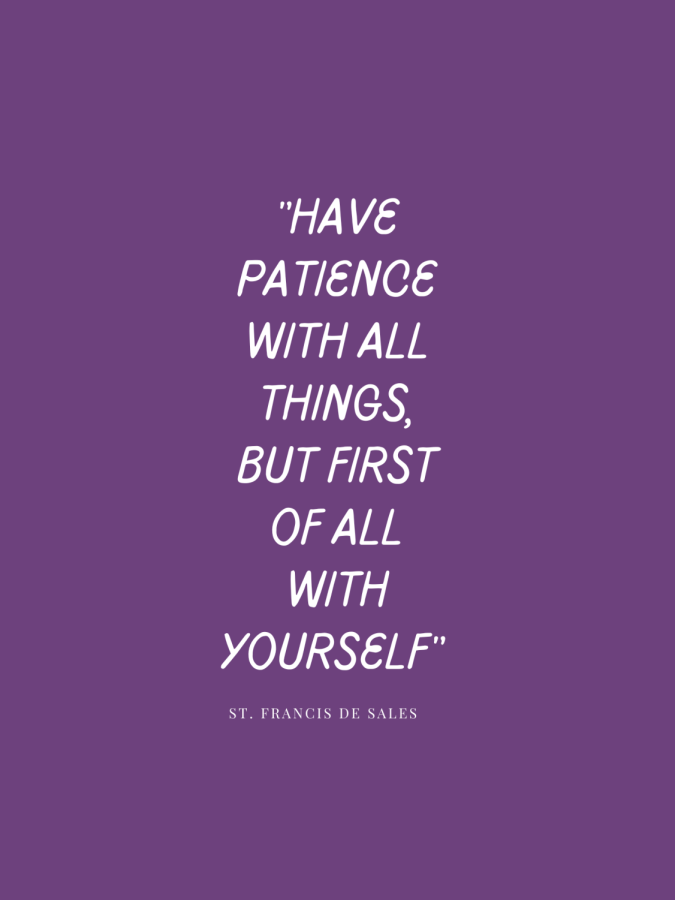How To Make A Lenten Plan
“Lent is like a long ‘retreat’ during which we can turn back into ourselves and listen to the voice of God, in order to defeat the temptations of the Evil One.” -Pope Benedict XVI
With Lent on the horizon once again, it’s time to start thinking about resolutions and sacrifices. I don’t know about you, but I certainly have trouble coming up with resolutions that are equally challenging and sustainable. Last year, I tried something new when it came time to decide what I was going to commit to for the 40 days of the Lenten season. This new method helped me to keep track of what I was working on and stick to it when I felt tempted to jump off the bandwagon, and it’s the method I plan on using this year. I would especially recommend this if you’re the kind of person who relies on lists, color coding, and planners to stay organized.
So, how does this method work? It’s based on the three pillars of Lent: Prayer, Fasting, and Almsgiving. All you need is a blank sheet of paper (maybe two), a pencil, and pens or colored pencils in three colors: purple, yellow, and red.
Step 1:

Divide the paper into three vertical columns. Draw horizontal lines halfway and three quarters of the way down the paper.
Step 2:
At the top of the larger boxes, write “Prayer”, “Fasting” and “Almsgiving”. Label each row of boxes as shown in the picture:
Before we continue, a word of advice: be wise about the disciplines you choose to take on. You are going to have to stick to these for forty days. That is more than a month. Try to pick resolutions that are achievable and sustainable.
For example: If your family doesn’t go to daily Mass every day, and you don’t have a driver’s license to drive yourself to church, going to daily Mass every day during Lent may not be the right discipline for you this year (unless you convince a parent or older sibling to go with you).
Another example: Suppose your chosen discipline is to say 5 rosaries, 3 Divine Mercy chaplets, and the Stations of the Cross every day for all of Lent. Some people will be able to pull this off easily and with grace. But if your schedule is busy and unpredictable, chances are you wont be able to sit down uninterrupted for over an hour every day. Instead, pick something more attainable; maybe say one rosary and Divine Mercy chaplet every day, which won’t take more than thirty minutes.
Another piece of advice: If you know you have an especially hard time choosing and sticking to disciplines, start out by picking disciplines that are similar to your everyday hobbies and interests. If you are an avid reader who despises watching television, maybe stick to reading only spiritual books for Lent instead of giving up TV, which won’t affect you very much. Or if you love working with wood but don’t listen to music much, work on a religious project, like a home altar, over the course of Lent instead of giving up secular music. In other words, know yourself.
Finally, it is important that the next few steps are done in pencil. If you find that one of your Lenten disciplines is far too unachievable for your current state in life, you can erase what you wrote down and simplify it so that it isn’t an impossible goal. Or if you chose something too easy and halfway through March you feel as if you’ve done nothing, you can use your handy dandy pencil to add an additional discipline or intensify an existing one.
Moving on…
Step 3:
Let’s take a look at the Prayer column. Take a moment and reflect: What is an area of your prayer life that you’d like to improve? Do you have any bad prayer habits that you need to abolish? Write any ideas, possible disciplines, and sacrifices on the extra sheet of paper. Take those ideas and pick a few small ones or 1-2 big ones. Write them down in the “Lent” box. Remember: make them doable.
For the “Holy Week” box, write an extra simple discipline or practice that you can add on during Holy Week.
In the “Sunday” box, write down which of the above disciplines you are going to waive on Sundays. The Prayer column would be the only exception to this. In my personal experience, I find Prayer practices to be the hardest to keep up, so I usually continue my Prayer disciplines right through Sunday. An extra prayer never hurt anyone.
Step 4:
In the Fasting column, think about any bad habits you want to break. This is the place for them. Your fasting disciplines do not have to be confined to merely food-related disciplines. You can fast from music, television, social media, and so many other things as well.
For the “Holy Week” and “Sunday” boxes, it’s the same idea as in the previous section. Add an extra practice for Holy Week and pick which discipline you are going to waive on Sundays.
Step 5:
By now, you should have a pretty good idea for what to do with the Almsgiving box. Almsgiving is usually practiced by making some sort of monetary contribution to the Church or the poor. But if you don’t have an income from which to donate, you can always donate your time. Picking up an extra chore for a sibling, being on time for commitments, and offering to watch your younger siblings for an evening is a great way to donate your time.
As for the “Holy Week” and “Sunday” boxes, you know what to do.
Step 6:

Put your plan up somewhere where you can see it every day. Some ideas as to where to put it are your bathroom mirror, on your school desk, up on the wall of your room, or on your car’s front windshield.
(Okay, maybe not the front windshield.)
You know yourself best; make sure to put it somewhere you know you will see it often.
Step 7:
Use your plan! This is the most difficult step of all, because this is where self denial and discipline come in. You can do it! Find an accountability partner, if necessary, to check in with often and keep yourself on track.
That’s it! Did you try this Lenten planning method? Let us know in the comments!
Have a lovely Lent!

Lucía is a MODG sophomore from Southern California (SD). She's an avid writer, voracious reader, amateur surfer, and lover of chocolate chip cookies....







Katy • Mar 1, 2023 at 10:31 am
This is a great article Lucia!! It was very helpful with my planning.
anna • Feb 23, 2023 at 5:23 am
Great Article Lucia! Super helpful : )
Cecilia • Feb 22, 2023 at 3:07 pm
Loved this Lucía! It really helped me make an organized plan!!
anna • Feb 21, 2023 at 5:21 am
Great Article Lucia! Very helpful!